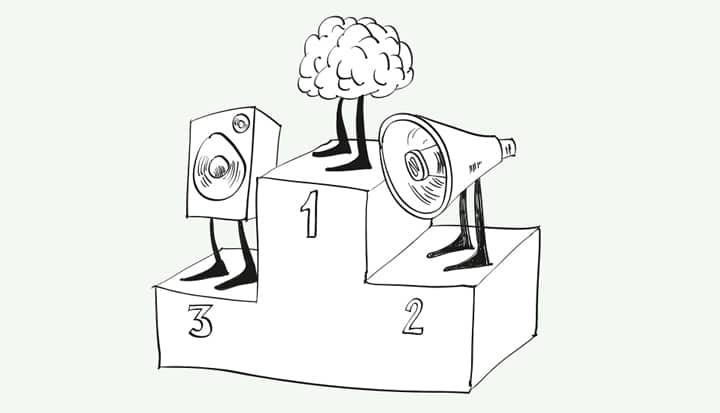In the world of social good, pitching is 90% of the battle – enrolling others into the change you believe. Gandhi did this. Martin Luther King shined with his ability to create a bridge into a tolerant and diverse future. Florence Nightingale wasn’t just a nurse, but a master storyteller. But what happens when you are pitching social good within a multinational corporation? When you are a cubicle warrior – fighting to transform organizations from the inside, your ideas are only as good as your pitch.
As an MBA student I had the fortune of interning for one of the coolest, most popular brands on the planet. I felt as if I had won the lottery – getting to work on the inside of an esteemed institution whose stories I had grown up with in my native Oregon. Even better – I was going to be working with their sustainability team to help make the business case for investing in people and planet.
I was fired up. I had the opportunity of my lifetime: to use my newly honed business skills to make a bad-ass business case.
Amongst the various initiatives we were developing – from investing in employee health and wellbeing to designing new products with lower environmental footprint – there was an opportunity to make change at scale. Rather than just focus on my own household impact, I found that I could reduce the company’s energy bill by installing more efficient lighting in all of its retail stores.
But what I discovered is that the guy in charge didn’t see this exciting opportunity in the same was as I. In fact, he didn’t seem to see an opportunity at all, but rather a massive hassle being thrust upon him by some eager intern.
I couldn’t understand it. The numbers were clear: invest now and make your money back in 3-5 years while also improving your eco-credentials with your customers and employees. How much more of a business case could you need?
And then it struck me. I wasn’t making a business case, I was making my case. I was using my own lens to determine what was important to the business without really listening to what mattered.
When I stopped selling and started listening, it was incredible what I learned. I learned that retail is essentially a throwaway business – companies completely renovate their stores on a regular basis, so investing in something with a 3-5 year payback was even too long a time horizon. I learned that lighting is important to retailers because it helps to sell products. The risk of losing profits trying out new technology outweighed the potential energy savings benefit – no matter how significant. And on and on.
So, when I listened I learned about the true priorities of the business. I also learned that the people doing the deciding about whether to invest or not are as human as you or I. And as humans, they make decisions not just on rational case making, but also on emotion and gut instinct.
In the end, what got decision makers excited wasn’t ROI – return on investment – but rather FOMO – fear of missing out. This was a company that had been a trendsetter since the 1970’s – and was used to creating waves not chasing them. Investing in sustainability was emerging as the next wave and their brand integrity was riding on their ability to get it right.
I share this story with you because the lessons I learned are part of a growing body of knowledge emerging from the decades-long movement to embed sustainability into the heart of business. The League of Intrapreneurs has attempted to codify some of this learning through a series of tools that capture the best tips and tricks from our community of corporate change agents.
In ‘Making the Business Case: How to combine the rational and emotional to win over your decision makers’ the League of Intrapreneurs shares numerous ideas big and small. Here are five tips for honing your intrapreneurial acumen:
1. Connect with Corporate Priorities
Take time to find out what really matters to decision makers in your company. Meet with people from across the business to find out what’s top of mind. Scan CEO statements or other corporate PR for publicly declared vision, mission and projects. How does your project support corporate goals? How can you help your company ‘enter new markets’, ‘innovate’, ‘drive growth’, ‘strengthen brand’?
2. Truly Listen
Take time to listen to people and understand their needs, priorities and motivations. Listening not only builds relationships between people, but also ensures that people feel
included and part of the process. Half of making the business case is getting others to make it for you – so listen and get others to do some of the heavy lifting by observing how they frame something or what resonates for them. Then incorporate their language in your communications
3. Back up your Hunch with Evidence
Hunches may appeal to true believers, but can isolate the majority. Hunches backed by
evidence de-risk your proposal. Make it easy for people to believe – for example, by showing them it’s been done before either in another field or at another time in history. Do your homework and share the data. You can’t expect most people to make leaps of faith – help to build bridges between today’s reality and tomorrow’s possibility.
4. Make it Stick
People can only process so much information, and many already feel overloaded.
So amidst meeting notes, agendas, emails, and Power Point presentations, how do you really get your message to stick? Sometimes it is as easy as having a conversation in a unique or memorable setting. Rather than pitch someone in a meeting room, try to go for a walk with them or visit a museum together. Getting people outside of the office may encourage their receptivity to your ideas because they will be in a more relaxed and open frame of mind. Other times presenting striking visuals or prototypes that are unexpected communication tools can get people engaged and get them to remember you and your idea.
5. Be Authentic
Human beings have a finely tuned b—-s—- detector. As a result, much of the art of
persuasion boils down to being authentic. Help your audience understand who you are. We identify with someone on a human basis. A story creates an underlying emotional connection with someone. Don’t be afraid to go personal.
The bottom line? Making an effective business case is less about business and more about people – understanding the underlying motivations of decision makers is the single best way to get your idea off the page. Pitching isn’t just a skill of entrepreneurs and those working to make change from the outside – but should be part of the DNA of anyone looking to create shift within organizations.
Over the coming months, we will be diving into the corporate trenches and featuring key tools and tactics that social intrapreneurs are using to drive change from the inside. Stay tuned…
This blog is the first in a 5-part series with the League of Intrapreneurs, and is accompanied by a live Intrapreneurship Clinic. Twice a month, members of Business Fights Poverty will have the opportunity to engage with Maggie De Pree, a lead author a the new Cubicle Warriors Toolkit, and other invited panelists. Each time, we will focus on a different element of the Tooklit.
Maggie De Pree is an entrepreneur and a mother. She co-founded the League of Intrapreneurs, a global movement for corporate change agents as well as The Human Agency, a community of strategic thinkers and do-ers working to incubate game changing ideas for humanity. Follow Maggie on Twitter (@MaggieDePree)










